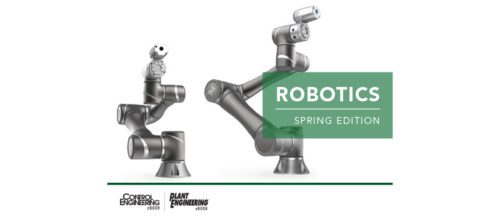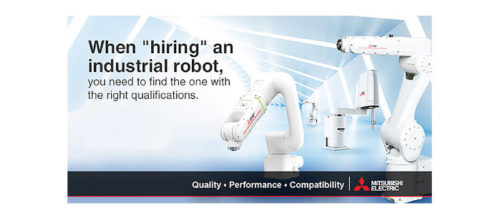7 things required for a successful cobot deployment
Choosing a collaborative robot (cobot) involves many aspects and manufacturers will need to decide on many things including whether to hire an integrator and what risks may be involved.
Learning Objectives
- Collaborative robots (cobots) can help manufacturers improve efficiency and safety, but many questions must be answered first.
- A company needs to determine early on if they can build the cobot itself or if a system integrator is needed.
- Proper research on cobots and what they can and can’t do for a manufacturing facility is critical./li>
The emergence of collaborative robots has created new paradigms for industrial automation. Industrial robot deployments traditionally required massive capital investment, teams of engineering and programming specialists and many months of lead time.
Some large-scale industrial robot deployments can take years and tens of millions of dollars to complete. That’s before factoring in ongoing maintenance, programming and support costs.
How are collaborative robotics expanding automation?
Cobots changed that by providing manufacturers with a viable alternative to traditional automation’s complex, costly, and time-consuming “all-or-nothing” approach in the form of a modernized, human-friendly automation paradigm. They can be used in many industries, such as electronics manufacturing, metal fabrication and others. Collaborative robots, less expensive and easier to deploy than traditional robotics (even by those without robot experience), have expanded use of automation to thousands of small- and medium-sized businesses.
Additionally, unlike traditional robots, cobots can be safely deployed in the same workspace as humans without the need for extensive safety fencing and guarding, following a risk assessment. With floorspace at a premium in most industrial and manufacturing settings, cobots’ small footprint, safety features and cage-free deployment possibilities add to the fast-growing global appeal of cobot technology.
Cobots can be deployed close to humans without special fencing (following a risk assessment) and are easy to program. They also can deliver massive improvements in ergonomics for existing workers by taking over the repetitive, heavy-duty tasks that lead to strain and injury. This frees human workers to focus on higher-value tasks. Cobots also provide 24/7 availability and consistent performance which leads to improved quality outcomes compared to tasks performed manually.
Collaborative robots can help fill labor shortages
The shortage of available labor is a long-term challenge for the manufacturing sector and a challenge that has been exacerbated by the COVID-19 pandemic; 62.4% of respondents to a National Association of Manufacturers (NAM) survey in December 2020 identified attracting and retaining a quality workforce as their primary business challenge.
Cobots are an effective way for manufacturers to address these labor gaps, enabling companies to increase production and throughput and improve quality, despite ongoing labor market shortfalls. As it becomes more difficult to find labor for material handling, welding, small parts assembly, and computer numerical control (CNC) machine tending, and welding tasks, cobots have been picking up the slack.
Valued at around $674.9. million in 2020, the global cobot market is expected to increase at a compound annual growth rate (CAGR) of 28% through 2025, according to market analysts BIS Research. Similarly, Emergen Research predicts cobot sales will climb to $9.3 billion by 2027, up from around $700 million in 2019. Meanwhile, numbers from the International Federation of Robotics (IFR) reveal cobots are the fastest-growing segment of the industrial robot market.
Three reasons for collaborative robotic automation
The early adopters of cobot technology in the late 2000s were buying into several new ideas such as:
- Automation could be safely deployed around humans
- Automation could be programmed and deployed by manufacturing personnel rather than industrial robot experts.
- Automation can be introduced and in a way that doesn’t require large-scale changes to existing floorplans, which is especially valuable for smaller companies.
How to successfully deploy collaborative robotics
So far, the early cobot adopters have been proven right. Cobots have demonstrated their utility across tens of thousands of successful deployments in the automotive, manufacturing, pharma and electronics sectors and on applications as diverse as machine tending, assembly, finishing, inspection, packaging & palletizing. Today, cobots account for approximately 5% of the global industrial robot market. Research from Interact Analysis predicts that will increase to around 30% by 2027.
With cobots on the brink of going mainstream, it’s time to explore some of the key questions that can help drive a successful cobot deployment.
1. Cobot implementation: Choose between do it yourself and hiring an integrator
Due to their ease-of-use and small footprint, cobots are ideally suited to do-it-yourself implementations. If your application is a simple one –such as a pick-and-place operation—then companies should feel confident in their ability to handle the deployment in-house. DIY deployments are considerably cheaper than those that require integration specialists, which is a major attraction for small companies with limited automation budgets.
Keep in mind there are considerable variations in the quantity and quality of the educational resources provided by different cobot makers. Particularly for those with little or no previous robotics experience, it’s essential to identify cobot brands that provide the online training, education and support required to implement a cobot in-house.
For more complex applications, or for any reason, the in-house capabilities don’t extend to a full deployment. Companies need to choose among three types of integration.
- A value-add distributor is the least expensive and will provide technical assistance to help facilitate a sale and will recommend configurations and peripherals.
- A Lean integrator often focuses on a specific application (welding, for example, or surface finishing) and measures integration time in weeks.
- A traditional system integrator builds a cobot-based cell from scratch, integrating all the peripherals and hardware required in a turnkey cell. Traditional integrators measure lead times in months, making for a more expensive and complete integration process.
2. Identifying the cobot application risk factors
Every application is different and presents its own challenges. Some risks are inherent to the process, such as arc welding. Other risks arise from the addition of extra complexity, such as when a vision system is added to a cobot cell. The environment also can present risks, particularly in relation to moisture and temperature levels. Factors such as how close to maximum payload you operate your cobot can impact on the lifespan of the equipment. Ask your cobot manufacturer for an application risk scorecard that can help you make an informed assessment of these factors.
3. Performing a cobot risk assessment
Risk assessments are an obligatory part of the cobot deployment process. For guidance on completing a risk assessment, visit the A3 Robotics website (part of the Association for Advancing Automation), which provides excellent robot safety resources and training. Elsewhere, the European Union-funded COVR project recently released a free, digital toolkit that provides a central repository of information and guidance regarding risk assessments, case studies, safety directives, international standards, and best practice in cobot safety.
4. Making the business case for cobot investment
The business case for cobots is compelling, but detailed return on investment (ROI) information is required by many executives when it comes to making any automation investment. Ask your cobot supplier for a ROI worksheet and instructions on how to calculate total benefits from a cobot installation.
True ROI values go beyond labor costs. They also incorporate overall equipment effectiveness (OEE), which is aa measure of how well equipment is utilized versus its maximum potential when it is scheduled to run, and overall labor effectiveness (OLE), which determines how well the company uses its highest-performing personnel, adjusted for variables such as availability, throughput and quality.
5. Upskilling the workforce to become cobot operators
This first step to ensuring painless upskilling of existing staff to become cobot operators is choosing a cobot that is high on usability. If the cobot is easy to program via teach pendant, smartphone or tablet computer, one of the main obstacles to successful upskilling has been eliminated right away.
After that, select a cobot ambassador to champion the technology. Due to the “wow” factor associated with cobots, the challenge here will likely not be finding a cobot champion, but sorting through several enthusiastic applications for the role.
Look for cobot brands that provide education and training resources. This will help streamline the training process and reduce implementation times. Quality also matters, so look for well-established cobot training curriculums, especially those that result in industry-recognized certification.
6. Picking the right accessories for a cobot application
Cobots are platforms that enable an incredible variety of applications from precise inspection tasks to heavy duty palletizing operations, but to complete a system, select some type of end-of-arm-tooling. Remember that not all cobots are created equal. Perform due diligence and ensure to invest in cobots that are certified plug-and-play compatible with the widest range of end-of-arm-tooling, hardware and software peripherals.
Additionally, look for cobot brands that understand how cobots are used in different application-specific scenarios – such brands will offer complete application kits with all the software and hardware required to get started on a specific task. Does your cobot brand provide application building guidance, resources and support? It should.
7. Performing cobot research
There is so much information available online about collaborative robots that the biggest challenge is navigating through it all. Real-world case stories are a good place to find practical information about cobot deployments and outcomes. White papers can help focus attention on a particular application, topic or industry. With many new entrants to the cobot manufacturing market over recent years, focus research on information from companies with a proven track record in the field. Independent sources of cobot information worth exploring include TÜV Rheinland, A3 and the European Union-funded COVR project.
Joe Campbell, senior manager of applications development, Universal Robots. Edited by Chris Vavra, web content manager, Control Engineering, CFE Media and Technology, cvavra@cfemedia.com.
MORE ANSWERS
Keywords: collaborative robots, risk assessment, cobots
CONSIDER THIS
Are your competitors accelerating with collaborative robotic implementations?
Do you have experience and expertise with the topics mentioned in this content? You should consider contributing to our CFE Media editorial team and getting the recognition you and your company deserve. Click here to start this process.



